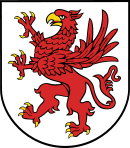| House of Griffin | |
|---|---|
 | |
| Parent house | House of Piast [1] [2] or Gryfit family [3] |
| Country | |
| Founded | 12th century |
| Founder | Wartislaw I |
| Final ruler | Bogislaw XIV |
| Titles | |
| Dissolution | 1660 |
The House of Griffin or Griffin dynasty [4] (German : Greifen; Polish : Gryfici, Danish : Grif; Latin: Gryphes [5] ) [a] was a dynasty ruling the Duchy of Pomerania from the 12th century until 1637. The name "Griffins" was used by the dynasty after the 15th century [10] and had been taken from the ducal coat of arms. Duke Wartislaw I (died 1135) was the first historical ruler of the Duchy of Pomerania and the founder of the Griffin dynasty. The most prominent Griffin was Eric of Pomerania, who became king of the Kalmar Union in 1397, thus ruling Denmark, Sweden and Norway. The last Griffin duke of Pomerania was Bogislaw XIV, who died during the Thirty Years' War, which led to the division of Pomerania between Brandenburg-Prussia, Sweden and Poland. Duchess Anna von Croy, daughter of Duke Bogislaw XIII and the last member of the House of Griffin, died in 1660.
Contents
- Name of the Dynasty
- Origins and branches
- Family tree
- Wartislaw I to Bogislaw IV and Otto I
- Bogislaw IV to Bogislaw X (Pomerania-Wolgast, -Barth, and -Stolp)
- Otto I to Otto III (Pomerania-Stettin)
- Bogislaw X to Bogislaw XIV
- Branches
- Ratiborides
- Swantiborides
- Griffins Kings and Queens
- Burial sites
- Eponymy
- Sources
- See also
- Notes
- References
- External links

